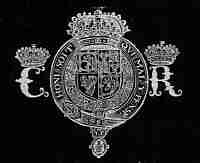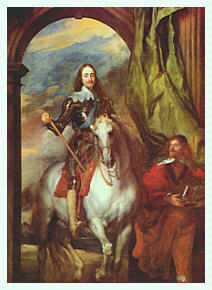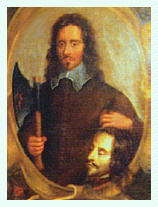THE LIFE OF CHARLES
I, KING OF ENGLAND
 Charles Stuart
was born in 1600 to James IV of Scotland and Anne of Denmark. With
the death of Queen Elizabeth I in 1603, James succeeded to the throne of
England as King James I, and moved his family, including the three year
old Charles, to England. Upon the death of his older brother Henry
in 1616, Charles became the appointed successor to the crowns of England,
Ireland, and Scotland; he assumed this office following the death of his
father in 1625.
Charles Stuart
was born in 1600 to James IV of Scotland and Anne of Denmark. With
the death of Queen Elizabeth I in 1603, James succeeded to the throne of
England as King James I, and moved his family, including the three year
old Charles, to England. Upon the death of his older brother Henry
in 1616, Charles became the appointed successor to the crowns of England,
Ireland, and Scotland; he assumed this office following the death of his
father in 1625.
From the beginning, Charles I's reign was troubled. Most English
subjects during the early Stuart period were intensely anti-Catholic, a
legacy of the many dangers -- for example the Spanish Armada War in the
1580s and the Gunpowder Plot to blow up the Houses of Parliament -- the
nation had experienced in earlier decades. As king, Charles's actions
ran almost completely counter to the nearly hysterical anti-Catholicism
of the age: in 1625 he married Henrietta Maria of France, a practicing
Catholic, and allowed her entourage of priests to set up residence in London;
in 1627, following a disastrous military campaign in France, he recalled
English troops from the Thirty Years War, leaving most of western Europe
prey to the military might of Catholic Spain and France. Rather than
heeding the appeals of his subjects for measures against the perceived
Catholic threat, Charles I embraced a political philosophy which assumed
the divine right of monarchs to form and administer national policy.
Thus, in 1629 he dismissed Parliament and proceeded to rule the nation
alone for eleven years.
 In the eleven
years known as the "personal rule",Charles's actions continued to aggrivate
his contemporaries. In particular, his support for changes in the
Church of England -- many of which seemed to place the Church's doctrine
and rituals in line with Roman Catholicism -- triggered fears of a "popish
plot". When in 1640, Charles was forced to recall Parliament in order
to finance a military expedition to a rebellion in Scotland, the crisis
reached a head. Radicals in the House of Commons pushed heavily for
thorough-going reforms in the administration of the Church and State, and
pursued virulent anti-Catholic policies. The protests against royal
policy were not limited to the Commons, particularly after news of a bloody
Catholic rebellion in 1641 led many to believe that the long-feared "popish
plot" against English religion and liberty was at hand. In the midst
of almost daily riots in London, Charles thus fled the capital in early
1642.
In the eleven
years known as the "personal rule",Charles's actions continued to aggrivate
his contemporaries. In particular, his support for changes in the
Church of England -- many of which seemed to place the Church's doctrine
and rituals in line with Roman Catholicism -- triggered fears of a "popish
plot". When in 1640, Charles was forced to recall Parliament in order
to finance a military expedition to a rebellion in Scotland, the crisis
reached a head. Radicals in the House of Commons pushed heavily for
thorough-going reforms in the administration of the Church and State, and
pursued virulent anti-Catholic policies. The protests against royal
policy were not limited to the Commons, particularly after news of a bloody
Catholic rebellion in 1641 led many to believe that the long-feared "popish
plot" against English religion and liberty was at hand. In the midst
of almost daily riots in London, Charles thus fled the capital in early
1642.
Charles I's flight from London precipitated a crisis in English politics.
The war of words between the King and his Parliament over the location
of sovereignty in the nation escalated throughout 1642. Charles claimed
that the divine gift of the royal prerogative could not be steered by the
whims of unruly masses; in response, Parliament claimed that the King had
been seduced by evil counselors who were bent on steering the nation toward
popery, and maintained that the people of the nation, embodied in Parliament,
had a responsibility to rescue their monarch from the clutches of these
evil interests. The competing ideological views of kingship and authority
eventually escalated into physical confrontation, with Parliamentary (or
Roundhead) and Royalist (or Cavalier) armies clashing at the Battle of
Edgehill in October 1642.
 For the next
four years, the English Civil War remained at a stalemate, with both sides
unable to achieve a convincing victory. Consequently, Parliament
pursued military reforms in 1645, resulting in the formation of the New
Model Army, a more efficient fighting force than that which either the
Cavaliers or Roundheads had raised 1642. These reforms shifted the
tides of the war and, in May 1646, his military options rapidly disappearing,
Charles I surrendured to a Scottish army at Newark, thus ending the first
English Civil War. The king was subsequently turned over the the
English Parliament, and imprisoned outside London.
For the next
four years, the English Civil War remained at a stalemate, with both sides
unable to achieve a convincing victory. Consequently, Parliament
pursued military reforms in 1645, resulting in the formation of the New
Model Army, a more efficient fighting force than that which either the
Cavaliers or Roundheads had raised 1642. These reforms shifted the
tides of the war and, in May 1646, his military options rapidly disappearing,
Charles I surrendured to a Scottish army at Newark, thus ending the first
English Civil War. The king was subsequently turned over the the
English Parliament, and imprisoned outside London.
As negotiations for a reconciliation between the crown and Parliament
proceeded in 1646 and 1647, Charles plotted to regain power without subsuming
his authority to what he perceived as the tyranny of the mob in Parliament.
In late 1647, he escaped from his place of imprisonment at Hampton Court
and negotiated a treaty with the Scots. This began the second English
Civil War, a conflict which saw Charles allied with English royalists and
the Scots. Unlike the first war, which lasted just under five years,
this latter conflict was over within a few months. The New Model
Army, commanded by Oliver Cromwell, enacted a decisive victory over the
Scots at Preston in Augsut 1648, thus forcing Charles I to again surrendur
to his enemies.
 By this time,
Charles has gained a reputation as an "untrustworthy" king. Although
the vast majority of Parliament's supporters did not want to try the monarch
as a traitor to his nation, radical elements -- particularly those in the
ranks of the New Model Army -- clamored for justice. Hence, in December
1648, the equivalent to a military coup occured in Westminster. Those
who favored negotiations with Charles were forcibly excluded from sitting
in Parliament during the episode known as "Pride's Purge". In January
1649, the handful of MPs allowed to sit at Westminster agreed to
form a High Court of Justice, convicted Charles of treason, and ordered
him excecuted. This act was carried out on 30 January, and according
to an ordinance of the Rump Parliament, the crown itself was abolished.
By this time,
Charles has gained a reputation as an "untrustworthy" king. Although
the vast majority of Parliament's supporters did not want to try the monarch
as a traitor to his nation, radical elements -- particularly those in the
ranks of the New Model Army -- clamored for justice. Hence, in December
1648, the equivalent to a military coup occured in Westminster. Those
who favored negotiations with Charles were forcibly excluded from sitting
in Parliament during the episode known as "Pride's Purge". In January
1649, the handful of MPs allowed to sit at Westminster agreed to
form a High Court of Justice, convicted Charles of treason, and ordered
him excecuted. This act was carried out on 30 January, and according
to an ordinance of the Rump Parliament, the crown itself was abolished.
Interpretations of Charles I's rule vary greatly. If I have some
time, I will perhaps add this information. For now, here are some
basic books and website links on the Stuart monarchy and the English Civil
War:
Conrad Russell, The Causes of the English Civil War (Oxford,
199).
Lawrence Stone, The Causes of the English Revolution
Martyn Bennett, The English Civil Wars ()
Oh yeah, and a few cool pictures of Charles I sans head:




 Charles Stuart
was born in 1600 to James IV of Scotland and Anne of Denmark. With
the death of Queen Elizabeth I in 1603, James succeeded to the throne of
England as King James I, and moved his family, including the three year
old Charles, to England. Upon the death of his older brother Henry
in 1616, Charles became the appointed successor to the crowns of England,
Ireland, and Scotland; he assumed this office following the death of his
father in 1625.
Charles Stuart
was born in 1600 to James IV of Scotland and Anne of Denmark. With
the death of Queen Elizabeth I in 1603, James succeeded to the throne of
England as King James I, and moved his family, including the three year
old Charles, to England. Upon the death of his older brother Henry
in 1616, Charles became the appointed successor to the crowns of England,
Ireland, and Scotland; he assumed this office following the death of his
father in 1625.
 In the eleven
years known as the "personal rule",Charles's actions continued to aggrivate
his contemporaries. In particular, his support for changes in the
Church of England -- many of which seemed to place the Church's doctrine
and rituals in line with Roman Catholicism -- triggered fears of a "popish
plot". When in 1640, Charles was forced to recall Parliament in order
to finance a military expedition to a rebellion in Scotland, the crisis
reached a head. Radicals in the House of Commons pushed heavily for
thorough-going reforms in the administration of the Church and State, and
pursued virulent anti-Catholic policies. The protests against royal
policy were not limited to the Commons, particularly after news of a bloody
Catholic rebellion in 1641 led many to believe that the long-feared "popish
plot" against English religion and liberty was at hand. In the midst
of almost daily riots in London, Charles thus fled the capital in early
1642.
In the eleven
years known as the "personal rule",Charles's actions continued to aggrivate
his contemporaries. In particular, his support for changes in the
Church of England -- many of which seemed to place the Church's doctrine
and rituals in line with Roman Catholicism -- triggered fears of a "popish
plot". When in 1640, Charles was forced to recall Parliament in order
to finance a military expedition to a rebellion in Scotland, the crisis
reached a head. Radicals in the House of Commons pushed heavily for
thorough-going reforms in the administration of the Church and State, and
pursued virulent anti-Catholic policies. The protests against royal
policy were not limited to the Commons, particularly after news of a bloody
Catholic rebellion in 1641 led many to believe that the long-feared "popish
plot" against English religion and liberty was at hand. In the midst
of almost daily riots in London, Charles thus fled the capital in early
1642.
 For the next
four years, the English Civil War remained at a stalemate, with both sides
unable to achieve a convincing victory. Consequently, Parliament
pursued military reforms in 1645, resulting in the formation of the New
Model Army, a more efficient fighting force than that which either the
Cavaliers or Roundheads had raised 1642. These reforms shifted the
tides of the war and, in May 1646, his military options rapidly disappearing,
Charles I surrendured to a Scottish army at Newark, thus ending the first
English Civil War. The king was subsequently turned over the the
English Parliament, and imprisoned outside London.
For the next
four years, the English Civil War remained at a stalemate, with both sides
unable to achieve a convincing victory. Consequently, Parliament
pursued military reforms in 1645, resulting in the formation of the New
Model Army, a more efficient fighting force than that which either the
Cavaliers or Roundheads had raised 1642. These reforms shifted the
tides of the war and, in May 1646, his military options rapidly disappearing,
Charles I surrendured to a Scottish army at Newark, thus ending the first
English Civil War. The king was subsequently turned over the the
English Parliament, and imprisoned outside London.
 By this time,
Charles has gained a reputation as an "untrustworthy" king. Although
the vast majority of Parliament's supporters did not want to try the monarch
as a traitor to his nation, radical elements -- particularly those in the
ranks of the New Model Army -- clamored for justice. Hence, in December
1648, the equivalent to a military coup occured in Westminster. Those
who favored negotiations with Charles were forcibly excluded from sitting
in Parliament during the episode known as "Pride's Purge". In January
1649, the handful of MPs allowed to sit at Westminster agreed to
form a High Court of Justice, convicted Charles of treason, and ordered
him excecuted. This act was carried out on 30 January, and according
to an ordinance of the Rump Parliament, the crown itself was abolished.
By this time,
Charles has gained a reputation as an "untrustworthy" king. Although
the vast majority of Parliament's supporters did not want to try the monarch
as a traitor to his nation, radical elements -- particularly those in the
ranks of the New Model Army -- clamored for justice. Hence, in December
1648, the equivalent to a military coup occured in Westminster. Those
who favored negotiations with Charles were forcibly excluded from sitting
in Parliament during the episode known as "Pride's Purge". In January
1649, the handful of MPs allowed to sit at Westminster agreed to
form a High Court of Justice, convicted Charles of treason, and ordered
him excecuted. This act was carried out on 30 January, and according
to an ordinance of the Rump Parliament, the crown itself was abolished.



